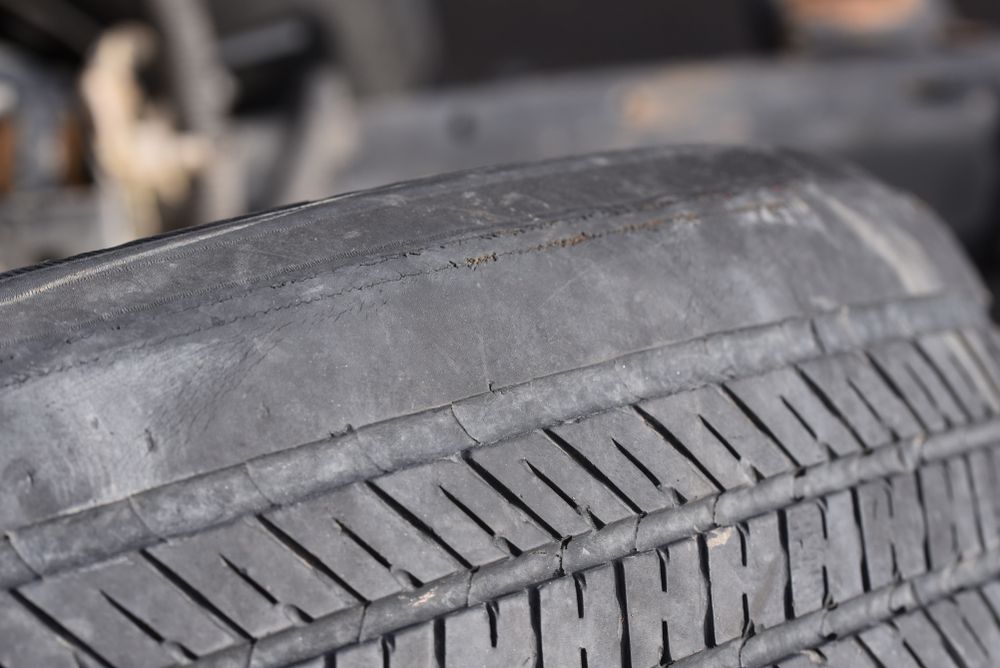Calculate Out-The-Door Price
close
With this easy test, a penny can buy you peace of mind when it comes to your tires and safety.
Place a penny head first into several tread grooves across the tire. If you always see the top of Lincoln’s head, your treads are shallow and worn. If this is the case, your tires need to be replaced.
If part of Lincoln’s head is always covered by the tread, you have more than 2/32 of an inch of tread depth remaining. This means you probably don’t need new tires.
When your tire treads are worn, your car may respond poorly in adverse weather conditions like rain and snow. With good treads, your car will grip the road better. Also, having insufficient tread is considered illegal in many states.
And finally, worn treads can make other parts of your car wear prematurely.
Potential Problem Areas:
When it’s time to change your tires, your Firestone Complete Auto Care dealer wants to make purchasing a new set as simple as possible. We have the best selection of quality tires to fit your vehicle, your budget and your driving style. From economy to ultra high performance tires - in the size you need from brands you trust, including our well-known Bridgestone and Firestone brands - you can find what you need right here.
Make a selection from the following options:
Shop for Tires
Find a Store Near You
Schedule an Appointment
{{storeNumber}}
{{storeName}}
{{link-icon "Call Us" mobileCallLink null "call-cta"}} {{link-icon "Directions" directions "_blank" "directions-cta"}}
{{address}}
{{city}}, {{state}} {{zip}}
{{#if activeFlag}} {{#ifCond mystore "or" myPreferredStore}} {{#ifCond storeType 'eq' "TPL"}}
*Call store for appointment {{phone}}
{{else}} {{#if onlineAppointmentActiveFlag }}
{{#if myPreferredStore}}
{{else}}
*Call store for appointment {{phone}}
{{/if}} {{/ifCond}} {{else}} {{#ifCond storeType 'eq' "TPL"}}
*Call store for appointment {{phone}}
{{else}}
Schedule Appointment {{#if onlineAppointmentActiveFlag}} {{else}}
*Call store for appointment {{phone}}
{{/if}}
{{/ifCond}} {{/ifCond}} {{else}}
*Temporarily Closed Due To: {{temporarilyClosedReason}}
{{/if}} {{#if isMilitaryStore}}
*This location is on an active US military base. You may need military ID to access the location.
You may need military ID to access the location.
{{/if}}
If you’re reading this site, there’s a serious chance that you’re a gearhead. We know the minutiae of the Corvette ZR1’s supercharger and can rhyme off the procedure to activate line-lock in the Mustang GT. Keeping an eye on tire wear, though? That seems mundane in comparison.
Folks who have a car simply for commuting necessity may be even further in the dark as to the condition of the rubber on each corner of their family hauler. Gearhead or not, we all have a responsibility to make sure the tires on our vehicles are in good shape. After all, they’re the only thing that actually touches the road.
Technically, a driver is rolling on worn tires the minute they leave the tire shop.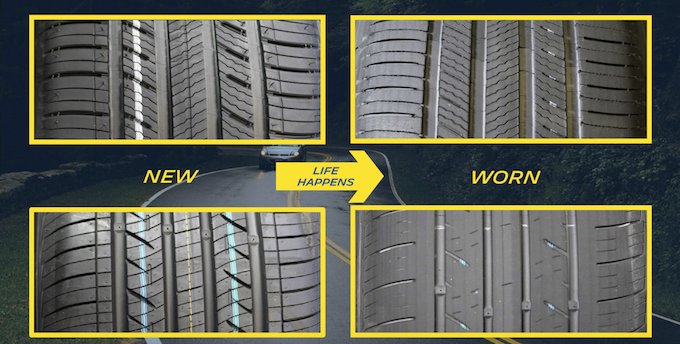 The change to a completely worn tire is gradual, sometimes taking years depending a person’s driving habits.
The change to a completely worn tire is gradual, sometimes taking years depending a person’s driving habits.
Think of it this way. If a parent sees their child daily, they’re likely not going to realize how much Junior has grown until he’s suddenly too big for the jeans he got for Christmas. It’s only when Nan and Pop appear to say “Look how tall you are!” is the difference realized. Our perception of a tire’s performance is much the same: gradual degradation goes unnoticed until a driver finds him or herself skidding sideways into the weeds.
At the risk of providing a response sure to provoke an eye-roll, the answer is “it depends”. The lifespan and amount of distance a driver can get out of a tire is dependent on a combination of factors:
A winter tire will wear more quickly, for example, thanks to its softer compound that plays well in the snow but gives up its life more quickly when pressed into dry pavement.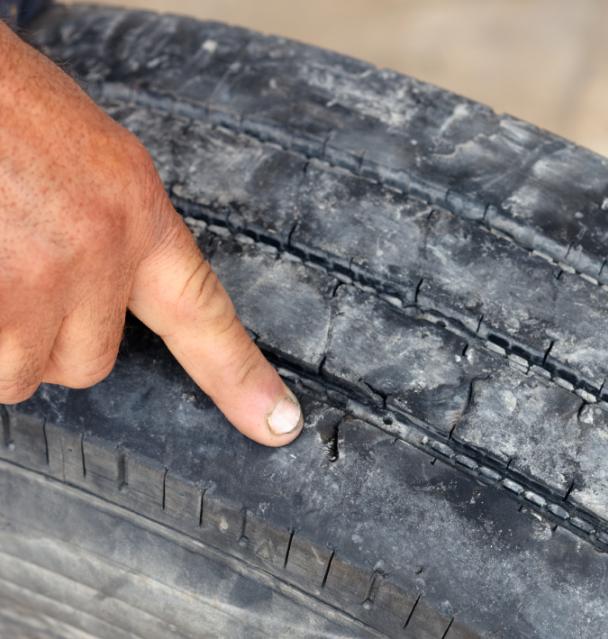 Drivers who accelerate and brake with vigor will find their tires do not last as long as their more sedate roadmates.
Drivers who accelerate and brake with vigor will find their tires do not last as long as their more sedate roadmates.
Tough weather is hard on both tires and the road surface, both of which affects a tire’s lifespan. And drivers who never check their tire’s inflation pressure or wheel alignment will find themselves wearing out rubber faster than a kindergarten kid enjoying his new eraser on the first day of school.
It’s important for drivers to give their tire more than a cursory glance at least once every couple of months or before heading out on a long road trip. Here’s what to look for in particular.
Examine the tread on your tires for any sign of uneven or odd wear. Between the tread blocks of all tires are small plain lines of rubber called ‘wear bars’. When these are exposed, a tire’s tread is worn down to the end of its useful life and has significantly less grip than it did when new. Driving on tires with this amount of wear can lead to a sudden loss of traction.
Driving on tires with this amount of wear can lead to a sudden loss of traction.
Yes, the tale your grandfather used to tell of using a quarter to determine a tire’s fitness is actually true. Put the edge of the coin into the tread, with the Queen going in head first.
If the top of the Queen's head is covered by tread, that's good. If the top of her head is entirely visible, it's time to replace the tire. The exact tread measurement for an end of life tire in Canada is 1.6mm.
Troublemakers like nails and stones stuck in the tire should be obvious and taken care of by a professional tire installer as soon as possible.
Pay attention to the “feel” of your tires as you drive. A rough ride may indicate tire damage or excessive wear. If you notice vibrations or other weird disturbances while driving, reduce your speed and drive with caution until you can safely pull off the road and stop.
If a tire is damaged, replace it with your spare (call Roadside Assistance if you’re not able to do this yourself). If you do not see any tire damage and cannot identify the source of the vibration, take the vehicle to a tire dealer for a thorough inspection.
The owner’s manual supplied with your vehicle will list the optimal amount of air that should be in each tire, generally stated in the measure of pounds per square inch and denoted as ‘psi’. A tire pressure gauge will be necessary to perform this task, and its instruction manual will have detailed instructions on how to use it.
Underinflated or overinflated tires can wear down faster than expected, have reduced grip, and can consume more fuel. For best results, check your tire pressure when tires are cool – before driving the car or if it has covered less than 5 kilometres at low speed
Even if all of the above is good-to-go on your set of rubber, make sure your tires aren’t aged to the point of it being a problem. Simply because they were purchased two or three years ago doesn’t mean that’s their actual age.
Simply because they were purchased two or three years ago doesn’t mean that’s their actual age.
Every tire has a date code, a four-digit number inside an oval stamped on the tire’s sidewall, generally found at the end of a line of numerals starting with “DOT”. The first two numerals describe the week the tire was made, the last two describe the year. For example, 1618 indicates the tire was manufactured on the 16th week of 2018. Many major tire manufacturers recommend replacing tires at the five year mark, even if the tread is deep.
The experts at Quattro Tire.com will be able to get you a new set of tires for whatever vehicle you’re piloting. Best of all they are fully Canadian.
Also Read: 5 Signs That you Might Need to Replace your Tires
Follow Wheels.ca on
Instagram #wheelsca
Living in rural Nova Scotia, Matthew Guy has immersed himself in car culture for over 30 years and relishes the thought of a good road trip. A certified gearhead, he enjoys professionally writing about cars and is very pleased to contribute for wheels.ca.
His work has also appeared on Car Throttle, The Truth About Cars, and in CAA Magazine. Find him on Twitter @matthewkguy
A certified gearhead, he enjoys professionally writing about cars and is very pleased to contribute for wheels.ca.
His work has also appeared on Car Throttle, The Truth About Cars, and in CAA Magazine. Find him on Twitter @matthewkguy
SHARE:
REPORT AN ERROR
JOURNALISTIC STANDARDS
ABOUT WHEELS.CA
In fact, the average life of any tire is 5-7 years, but a lot depends on how the owner treats his car. Aggressive driving, improper seasonal tire storage, unrepaired suspension/balancing problems, incorrect pressure and other errors can significantly shorten tire life. But worn tires can be a serious problem on the road: an increased risk of uncontrolled skidding, hydroplaning, even accidents is the price that drivers and passengers have to pay for using old tires.
Each manufacturer indicates the so-called wear index on the tire profile, which most often looks like the inscription “Treadwear 100” and means a maximum of 48,000 km on a standard road surface (polygon). In a real environment and often not the most ideal roads, this number actually needs to be divided by 1.5 - we get 36,000 km.
In a real environment and often not the most ideal roads, this number actually needs to be divided by 1.5 - we get 36,000 km.
By analogy, if the wear resistance index is 150, then this means “factory” 72 thousand km, 200 - 96 thousand km., and so on.
What are the dangers of worn tires on the road:
adhesion to the roadway deteriorates, which leads to an increased likelihood of skidding, accidents, hydroplaning in case of rainy weather;
reduced cross-country ability in off-road conditions;
increases the risk of a tire puncture while driving.
It is also worth remembering that the issue of tire wear is regulated by traffic rules, and you can get a fine for using “bald” rubber. Knowing what maximum tire wear is acceptable, this is easy to avoid: 1.5-2 mm for summer, and 4-5 mm for winter (a more accurate figure is indicated by the manufacturer).
1.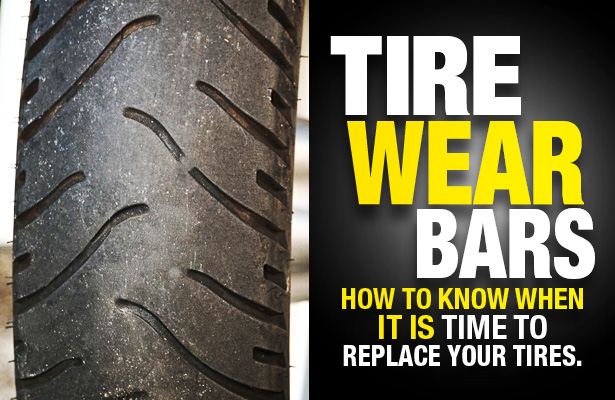 According to the wear indicator on the tire. To find this indicator, you need to inspect the side of the tire and find one of the markings: a triangle, a company logo, a snowflake, or the abbreviation TWI. If the tread has worn down to this indicator, it means that the tire needs to be disposed of urgently.
According to the wear indicator on the tire. To find this indicator, you need to inspect the side of the tire and find one of the markings: a triangle, a company logo, a snowflake, or the abbreviation TWI. If the tread has worn down to this indicator, it means that the tire needs to be disposed of urgently.
2. Many people in the old fashioned way prefer to use a 10-kopeck coin. Insert it into the tread with the inscription "10 kopecks" towards you, and if it is visible, the wear level is too high, you need to replace the tire. This method is convenient, but not entirely accurate: by measuring wear in different parts of the tire in this way, it will be difficult to estimate its unevenness by eye, and this is also an extremely important indicator.
3. It is optimal to use a special gauge, depth ruler or caliper for these purposes. This will allow you to measure the wear of the tread in different parts of the tire with an accuracy of up to a millimeter and understand if there is uneven wear.
If measurements show different results in different parts of the tread, it is important to determine exactly how your tires wear in order to understand where and what the operating error is.
If the tread wears more on the sides and the center wears off less, this means that the tire pressure is insufficient and the contact patch with the road is not correct. This leads not only to poor vehicle stability, but also to increased fuel consumption.
If the tread is worn down the middle but the sidewalls are fine, then your tires are overinflated. Sometimes this is done intentionally in order to save fuel, but in this case, the tires will still have to be changed ahead of schedule.
There is also the possibility of increased wear on the inside or outside of the tread - this indicates an incorrect camber. A visual table with wear options and their causes:
Cracks on the sides of tires can indicate frequent off-road driving, improper storage, low-quality rubber or long service life, as well as incorrect tire pressure.
Bulges or "hernias" on the sides of the tires appear as a result of the side part hitting hard obstacles. Tires with such damage are not recommended.
Dents on the tread indicate insufficient depreciation and unadjusted camber. Having found such damage, it is necessary to drive the car to the service and make sure that the suspension is in good condition.
Individual wear spots on the tread indicate aggressive driving / braking, skidding with wheel locks, or prolonged parking of the car in one position.
Most often, this is required for the sale and purchase of used tires in order to orient the buyer in the degree of their wear. Many sellers give this figure at random, but this method has nothing to do with the actual assessment of the degree of tire wear. It is also important to understand that a conditional 50% wear for a summer tire is an acceptable value, while 50% wear of a winter tire tread is a sign that the tire cannot be used.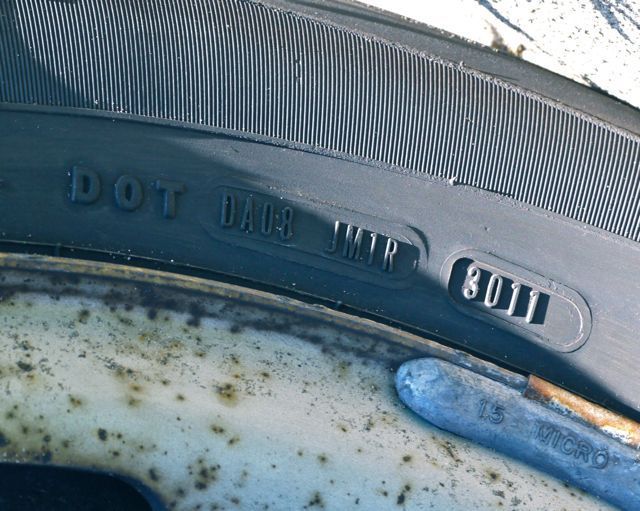 Therefore, it is important to know how to accurately determine the percentage of tire wear so as not to get into an unpleasant situation.
Therefore, it is important to know how to accurately determine the percentage of tire wear so as not to get into an unpleasant situation.
Many people divide the actual tread height by the height of the same, but new tire, and get a certain percentage of wear. This would be correct, if not for one BUT: we cannot physically erase the tread to zero, and the law prohibits the use of tires with a tread below the permitted values.
You can calculate actual tire wear by dividing the difference between the new tire height and the actual tire height by the difference between the new tire tread height and the minimum possible tread height for that tire, and then multiplying this number by 100.
If it is impossible to find out the height of the same, but with a new tire, use the average values of your tire type:
| Tire type | Average tread height at start of use |
| Winter tires with Scandinavian tread | 10 mm |
| Winter with regular or asymmetric tread | 9 mm |
| High-speed winter | 7 mm |
| Summer tires with classic tread | 8 mm |
| Summer speed | 7 mm |
You can check summer tires for wear a little less often than winter tires, since in summer the tread depth is not so important for patency.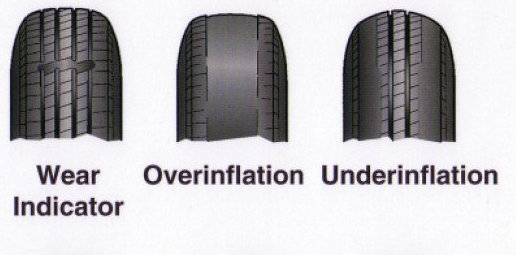
If you have assessed the condition of your tires on all of the above factors and realized that the tires are worn out, be sure to replace them with new ones as soon as possible.
Irina Zverkova
Estimated reading time: 4 minutes
133759
RIA Novosti
Tires are one of the most important components of a vehicle to ensure driving safety. Proper use of summer and winter tires during the season improves handling and saves the car owner money. But some drivers not only postpone changing tires depending on the weather, but also continue to use the same tires for several seasons. At the same time, wheel wear becomes more and more, and the threat that the tires will not cope with holding the car increases.
The tire tread is responsible for connecting the car to the road. This is the outer layer of rubber, which contains a certain pattern, suitable for different operating conditions. For summer tires, the removal of water from the contact patch is relevant, for winter tires - improved grip on slippery surfaces, for off-road tires - maximum cross-country ability. Regardless of the purpose of the tire, one of the important characteristics of the tread is its height or depth. This is the distance from the outer edge of the tire to the "bottom" of the groove. For new modern car tires, the height starts from 5 mm. For ordinary summer passenger tires, this value is 6–8 mm, for winter tires it is 8–10 mm, for SUVs it is 15–20 mm.
When the tread wears out (reducing its depth), the driving properties are the first to suffer: the car is more prone to aquaplaning. Winter tires lose some of their properties, which are provided by special sipes and studs. It is important to consider that different brands and models have different rubber composition, so some wheels “run” longer. The driving style also affects wear - more aggressive starts and active braking shorten the life of the tire.
The driving style also affects wear - more aggressive starts and active braking shorten the life of the tire.
9 is considered critical for tire wear0169 tread height of 1.6 mm for summer tires and 4 mm for winter .
Height can be measured using the ruler with the depth gauge or vernier caliper.
Those who do not have such tools can use a regular 10-kopeck coin placed in one of the grooves. If the word "kopecks" is hidden, it means that the tire is almost new and does not require replacement. If the tread covers only the floral ornament on the winter tire, then it will soon need to be changed; if it’s in the summer, the replacement will have to wait. If only the rim of the coin is hidden, you need to urgently install new tires.
On the left is a worn tire, on the right is a nearly new tire. Photo: AiF / Irina Zverkova Many modern manufacturers make wear indicator on tires (this is a protrusion perpendicular to the axis of rotation of the tire) or lay a special colored layer that becomes visible when the tire is erased.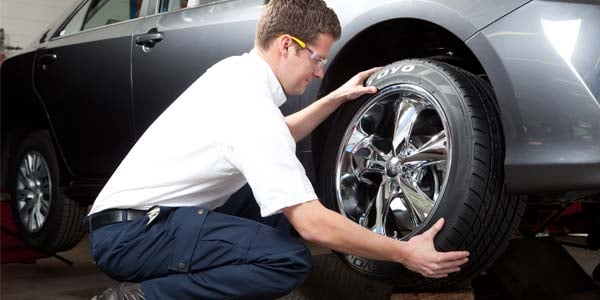 Their manifestation serves as a signal for the car owner to change tires.
Their manifestation serves as a signal for the car owner to change tires.
It is important to monitor not only the tread depth, but also the wear uniformity . To be sure that the wheel is in good condition, it is better to measure the tread depth at different places around the circumference along the entire width of the tire. If the inner or outer part is worn out more, then the wear of the tread is taken into account at a minimum value, and it is better for the owner to check the wheel alignment / collapse of the car.
If the vehicle has frequently been driven on bumpy roads, climbed curbs, or the tires have been run half-flat, the sidewalls may have dents, holes, cuts or cracks . It is better to check their condition at the tire shop before the wheel is flat at the most inopportune moment. For example, it may not withstand the loads in a turn, burst and provoke an emergency. You should be especially careful about such damage on low-profile tires.